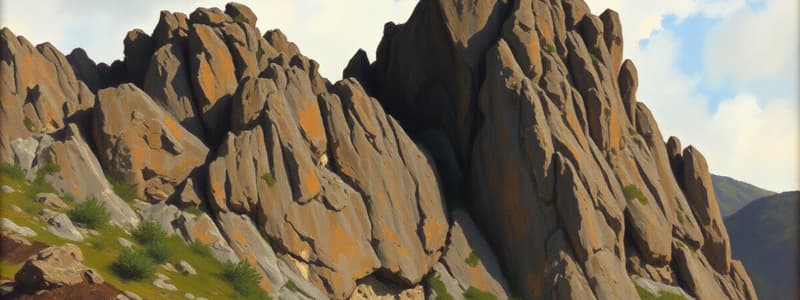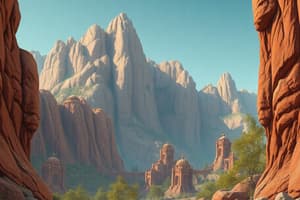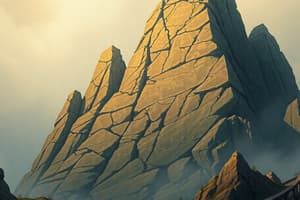Podcast
Questions and Answers
Which of these is NOT a weathering process?
Which of these is NOT a weathering process?
- Oxidation
- Erosion (correct)
- Frost wedging
- Hydrolysis
Which weathering process involves the breakdown of rocks by the action of freezing and thawing water?
Which weathering process involves the breakdown of rocks by the action of freezing and thawing water?
- Frost Wedging (correct)
- Abrasion
- Oxidation
- Carbonation
What is the primary cause of chemical weathering?
What is the primary cause of chemical weathering?
- Temperature changes
- Chemical reactions (correct)
- Biological activity
- Physical forces
Which type of weathering primarily affects rocks containing iron?
Which type of weathering primarily affects rocks containing iron?
Which of these is NOT a factor that can affect the rate of weathering?
Which of these is NOT a factor that can affect the rate of weathering?
Flashcards
Weathering
Weathering
The process of breaking down rocks and minerals at the earth's surface.
Physical Weathering
Physical Weathering
The breakdown of rocks through mechanical processes without changing their composition.
Chemical Weathering
Chemical Weathering
The alteration of rocks through chemical reactions, often involving water.
Biological Weathering
Biological Weathering
Signup and view all the flashcards
Factors Affecting Weathering
Factors Affecting Weathering
Signup and view all the flashcards
Study Notes
Introduction to Weathering
- Weathering is the process of breaking down rocks, minerals, and soil through physical or chemical means.
- It's a crucial element in the rock cycle, transforming larger rocks into smaller fragments.
- Weathering happens in place, meaning the material remains in the same location.
- It differs from erosion, where weathered material is transported away.
Types of Weathering
- Physical Weathering: This involves the breakdown of rocks without changing their chemical composition.
- Frost wedging: Water seeps into cracks in rocks, freezes, and expands, widening the cracks over time.
- Thermal expansion and contraction: Repeated heating and cooling of rocks can cause them to expand and contract, leading to cracking.
- Exfoliation: Pressure release from the removal of overlying rock layers causes rocks to crack and peel outwards.
- Abrasion: The grinding of rocks against each other by wind, water, or ice leads to their disintegration.
- Crystal growth: Crystallization of salts in cracks can exert pressure and break rocks apart.
- Chemical Weathering: This involves the alteration of a rock's chemical composition through reactions with the surrounding environment.
- Hydrolysis: Water reacts with minerals in rocks, weakening their bonds.
- Oxidation: Minerals react with oxygen in the air, often creating rust-like formations.
- Carbonation: Carbon dioxide in water reacts with minerals, forming carbonic acid, dissolving carbonates and other minerals.
- Solution: Certain minerals, particularly soluble salts, can dissolve directly into water.
- Biological Weathering: The breakdown of rocks due to the actions of living organisms.
- Plant roots: Roots growing into cracks in rocks exert pressure, causing them to fracture.
- Burrowing animals: Burrowing activities can loosen and break up soil and rock.
- Lichens: Lichens secrete acids that chemically weather rocks.
Factors Affecting Weathering
- Climate: Temperature and precipitation are significant factors influencing both physical and chemical weathering.
- Higher temperatures generally increase the rate of chemical weathering.
- More rainfall accelerates both physical and chemical weathering processes.
- Rock type: Different rocks have different resistance to weathering depending on their mineral composition and structure.
- Igneous rocks, like granite, tend to be more resistant to weathering than sedimentary rocks.
- Topography: Steep slopes can accelerate physical weathering by increasing the impact of water and other erosional agents.
- Time: Weathering processes require time to occur; the longer the duration, the greater the degree of weathering.
Products of Weathering
- Weathering results in the formation of various products, including:
- Sediment: Small fragments of rock and mineral material.
- Soil: A mixture of weathered rock, mineral particles, organic matter, and water.
- Dissolved ions: Minerals that have been dissolved and carried away by water.
Conclusion
- Weathering is a continuous process that shapes the Earth's surface over long periods.
- Understanding the different types of weathering and the factors affecting it is crucial for various applications, such as predicting erosion rates and managing slope stability.
Studying That Suits You
Use AI to generate personalized quizzes and flashcards to suit your learning preferences.




